FEB 18-22
This is 367km of difficult red-earth road interspersed by a few paved sections. Driving the entire route starts and ends in Bamenda, in the middle-west part of Cameroon. Drive through some of the finest scenery in Africa, the verdant pasturelands of the Grassfields – not savannah, but hilly meadows between stands of hardwood forest and patches of shifting agriculture. Natural sites include waterfalls, volcanoes and nearly forty, crystal-clear crater lakes, many of them sacred, and at least one (Lake Nyos) potentially dangerous. Terraced farmlands of green and yellow valleys, tall grass, and red earth frequent the steep slopes rising to sharp mountains; the mountain soils, ploughed along the contours, sustain crops like coco-yams, maize and plantains. Cash crops, such as coffee and tea, grow at higher elevations and Fula herders graze their cattle in the pastures. Clouds of mist rise with wood and dung smoke mark the location of villages speckled on the rugged terrain.
This is one of the greatest concentrations of fondons (traditional kingdoms) in Cameroon. Tourism is DIY here. Hiking and camping are options but always ask the local chief and bring some gifts.
The best way to tour the Ring Road is with your own vehicle. All the major towns, Bafut, Wum, Nkambe and Kumbo are accessible by public transport but this is infrequent past Wum and Weh. All these towns offer basic accommodations and food. However, many of the most interesting sites are off the main route unless you have your own transport. Camping, one of the Ring Road’s greatest pleasures, is problematic with public transport because of the difficulty of finding flat spaces that are not being actively farmed.
The northern stretch between Nkambé and Wum has been completely impassable to vehicles in the past due to collapsed bridges at Nyos and Weh. The road past Lake Nyos to Nkambé was almost non-existent with a high clearance 4×4 required, but in 2017, that part was graded and is now “good” road. There are few directional signs. The scenery through this part is also not very exciting and villages far apart if help is needed. Drivers at the Bamenda motor parks or the personnel at the Tourist Information Center can update you on road conditions.
Rain is a significant hazard as the red, clay-like mud makes travel virtually impossible in any vehicle (sticks like glue, slides like snot). One would have to wait a day or two for the road to dry. Travel in the dry season is thus best, but it can rain at any time. Cycling is possible but any rain stops you dead in your tracks.
A large-scale map (the Michelin map at 40km to 1cm is too small a scale) is required to follow the twisting village-dotted route. Also bring some bottles of local whiskey to present to the fons (chiefs), if you visit any of the palaces of the various chiefdoms.
One experience in Trip Advisor in 2015 used a Toyota RAV4 that survived it pretty well, but it lost every plastic protective piece below bumper level. The “road”, particularly near the Kimbi Wildlife preserve, was filled with large boulders, deep gullies, and no alternatives. At one point, it took about an hour to make a driving ramp in a gully with these boulders and then only made it through by emptying the car and carrying the bags about a quarter of a kilometer.
Had this scenery been spectacular–it probably would have been worth the effort. The northern route is simple, nondescript grassland (and in January, much of it burned out by fire) that resembles hilly back roads in Texas or Kansas, but without any charm. Even the Cameroonians know this–the area is sparsely settled. If something bad happens to your vehicle, you will have to walk a long way to find help. It is simply not worth it, even for bragging rights, to complete the entire thing. A 4 x 4 vehicle is a must on the northern section, less so for the two crescents.
ITINERARY
Everyone has a different idea about how to see this part of the country as evidenced by all the different plans of the various people in our group. The road conditions are a complete unknown and change by year and season. A motorcycle could negotiate almost any terrain. But camping would be difficult. Renting motorcycles is difficult. Available ones are all geared and thus some driving ability. Generally a driver would be necessary. A roomy 4×4 would be ideal to be able to go anywhere.
The worst section of road was supposed to be between Weh and Nkambe so we thought we would avoid it in our itinerary. I contacted several travel agencies in Bamenda to arrange a vehicle but none responded. A driver would be necessary as self driving is not possible (we have no International Drivers Licenses and no companies would rent a vehicle to do this trip without a driver). A driver would be best anyway as he would know the area and be able to deal with any mechanical issues. Insurance would also not be necessary.
We planned on camping and eating in local eateries. We brought cereal and milk, bananas, bread and jam for breakfasts and mayonnaise, mustard, salt and pepper to make sandwiches for lunch. We took tents, bowls, cups and cutlery from the truck.
BAMENDA
Set in pines and bananas, Bamenda is the capital of the North West Province and bubbles with political debate with riots in 1990 and 1995.
It is divided into two towns – the administrative section perched high on the steep escarpment known as the Up Station to the east (with the German red-brick fortress now the Provincial Education Authority, the German/British colonial cemetery and the favoured residential area) and connected by a tortuous road down to downtown Bamenda, a sprawling conglomerate of small businesses, neighborhoods, workshops and blasting stereos. The main market, behind Ideal Park Hotel, has good deals. The Tourist Office, 250m west of City Chemist Roundabout, has travel advice but not much more.
Google travel agents in Bamenda. Three companies I found on Google were Springboard, Cameroon Wonders and Skytrust, but there are many more especially around Chemist Roundabout.
We arrived in Bamenda at noon and changed money – a great rate for euros at 655 and poor for US$ at 550 at Express Exchange but 600 at the Main Market. Large bills did better than small bills. They wouldn’t even look at 10 and 5$ notes. It all took a couple of hours leaving limited time for us to deal with the transportation necessary for the trip. We stayed at the Presbyterian Mission in Bamneda, several in rooms and the rest camping.
While the four riding motorcycles went their way, Bruce, Andrew and I went searching for travel agents centered around Chemist’s Circle. We had contacted three agencies but none had returned emails. As we walked east from the circle we entered some agencies. The first offered a Toyota Rav for 60,000 CFA per day, a second a 4-Runner for 100,000, and a third with several available vehicles: a Toyota Corolla for 40,000 and a 4-Runner for 80,000. I walked away at that price and he came down to 60,000/day including driver. We were responsible for gas and food for the driver. He was camping with us and sleeping in the truck. Erasmus was a mechanic and driver, married with 3 children. Erasmus turned out to be a great guy.
The rest of the passengers on the main trip all had their own agendas and plans on how to do the ring road. Anders from Denmark and Alice from Australia stayed at the Drill Ranch in Nigeria for a few days, an appropriate name for romantic times. Mufi went to Lagos for unknown reasons – we think it must be a woman or to watch football (he has no problems spending money to watch a football game and had previously flown to Gabon to watch the finals of the Africa Cup of Nations). Soto and Bob stayed with the truck in Bamenda, as they had other priorities for the money (skydiving in Namibia, bungee jumping at Victoria Falls and a trip to New Zealand). Toby, a 19-year-old from Arun, Scotland was walking the Small Ring road (his only source of information was a schematic map of the route and I think he will miss the fons). Tammy and Andy (a couple form England) and Blake (form Ireland), easily the cheapest of the whole bunch, were using public transportation, camping and cooking along the way. They had huge packs with their bulky sleeping pads and bags, one of the huge (30 pound?) tour tents and a lot of add-hot-water noodles. They even bought diesel to be able to light fires. My bet is that they wouldn’t get to Lake Nyos because of the lack of public transport, but their plan was to get there after 2 days and then camp for a day there. Tom and Julia (an Englsih/New Zealand couple), Chris (England) and Mark (Canada) had the most hair-brained idea. They wanted to buy motorcycles and resell them after the trip!! but ended up hiring motorcycles and drivers for 60,000 each, staying in hotels and eating in restaurants as they have no ability to carry camping stuff. They would have the least difficulty navigating any road but none of us wanted to sit on a motorcycle for several hundred kilometres.
I had found the only four willing to spend money and would rent a proper vehicle, camp, prepare some of our own food and eat in restaurants. I think we were the only ones with a good knowledge of all there was to see as I had spent a few days doing research (Rough Guide, Lonely Planet, Trip Advisor and itineraries of tour companies). The proposed itinerary follows.
Day 1. Drive the West side of the Ring road to Lake Nyos. Camp.
Savanne Botanical Gardens? 15km
Bafut. Visit palace, museum. 20km.
Menchum Falls 50km
Wum 70kms. See view from verandah of hotel, eat lunch, Wum Lake
Lake Nyos. Camp Lake. Hike around lake?
Day 2. Return to Weh and drive Small Ring Road back to Baminda.
See Fundong and visit the palace of the Fon.
Belo. 3-hour hike in Ijim Forest.
Return to Baminda for night or camp on way to Kumbo
Day 3. Eastern Ring Road,
Kumbo 6 hours from Bamenda by share van – Banso Chiefdom
Elak – Oku Chiefdom, Mt Oku and Lake Oku.
Day 4.
Takija – If Friday, visit cattle market
Ndu – tea plantations
Could drive all the way to Nkambé.
Jakiri. View from Hotel Trans Afrique
Foumban. 75km side trip off Ring Road from Jakiri. See Fons Palace, Village des Artisans.
Day 5. Return to Bamenda
Bali Chiefdom (20km west Bamenda). Visit if have time.
RING ROAD – The Trip
The choice I recommended was doing the Ring Road as a nearly-closed “U” missing the difficult and less interesting northern section. Returning back down the western arm of the U allows you to see the popular Small Ring Road. This has the best scenery and allows visits to most of the chiefdoms, does not require a 4×4 in dry conditions and has access to accommodation and food.
A. BAMENDA TO LAKE NYOS
Savanne Botanic Gardens (15km). Park-like grounds with a good but pricey bar-restaurant. Camping available. We didn’t go here.
BAFUT (22km). The chiefdom of Bafut acquired international fame in the 1950s and 60s as the site of two animal collecting trips by the naturalist Gerald Durrell. The first was described in “The Bafut Beagles” makes amusing reading although a far cry from conditions today.

Abumbi II, the 11th fon of the Bafut, the only African king with over 100 wives and 500 children
Bafut is a Tikar community – people who migrated to Bafut in the 15th century from north Cameroon to escape attacks by slave traders. It is one of the most powerful and largest of the traditional kingdoms here. It exists on a 10km stretch of the road that follows along a ridge above the Menchum Valley. The present fon, Abumbi II is the titular overload of a large number of lesser fons in the region. He has 55 wives compared to his father’s 152 and was chosen from his father’s 199-odd offspring when his father died in 1971. He owns all the land and has about 8,700 cattle. The Tikkar are heavily Islamicised but have been subjected to intense Presbyterian missionary work.
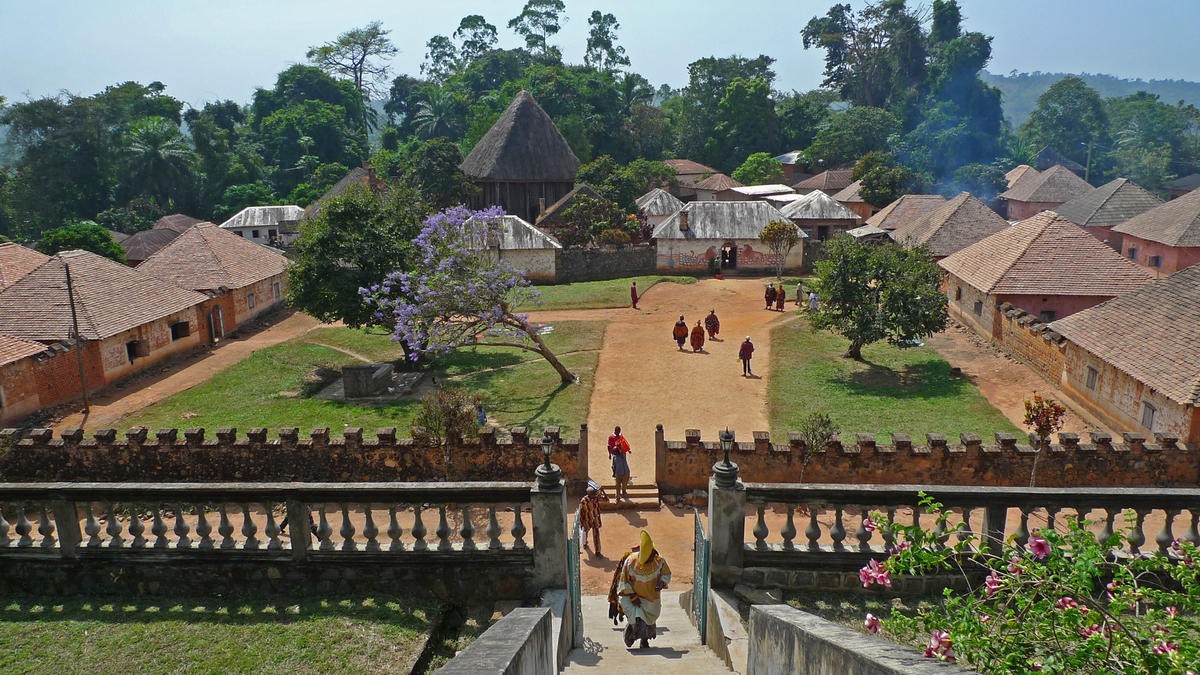
Fon’s Palace. The main attraction in Bafut is a large red-brick complex with dark interiors and bright courtyards. The sacred Achum is the previous fon’s palace with a striking pyramidal thatched roof. Dedicated to the ancestors, only the fon and other notables are allowed to enter this shrine.


The fon’s wives and sons act as tour guides to the royal compound and grounds (fee 2500 CFA + 2500 CFA for a camera). They give excellent insight into Bafut history and the many sacred rituals and traditions followed to this day. A bugler by the main gate announces the fon’s secret society and everyone must scurry inside on pain of death if they set eyes on them. There are also strict rules about what may be touched, so keep hands to yourself.
Museum. A highlight to a visit, it is housed in Gerald Durrell’s old residence overlooking the palace grounds. Originally built by the Germans for the fon to reside in, it was refurbished in 2003.
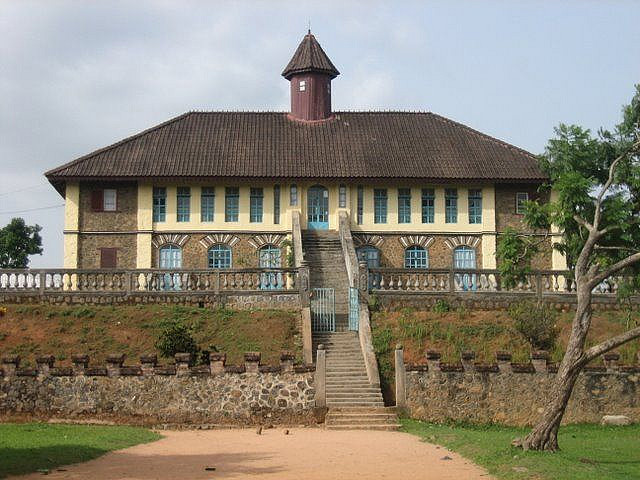
Topics range from the slave trade to Bafut ancestral spirits with some beautifully carved sculptures including one depicting the first European visitor. The Bafut people put up considerable resistance to the Germans before they finally surrendered.
Grass-cutting Ceremony. Still preformed on a yearly basis, the entire community goes into the grasslands at the end of the dry season (usually late April) to collect bundles for rethatching the Achum and other important buildings, trooping in front of the fon with their offerings. It’s a confirmation of community spirit ending up with tremendous feasting and palm wine.
Christmas Festival. A second annual festival occurring a week or so before Christmas has formal, dressy presentations and much discharging of old guns, dances and musical shows.
We met Blake in Bafut. They had paid 1000 CFA to camp in someone’s yard the previous night and were about to board a share taxi. They paid 2000 to visit the Bafut Palace and saved 500 by not seeing the museum. They bought no handicrafts and proudly announced that they had given 500 CFA for a tip.
Our experience: Tour cost 2500/person + 2500/camera + 500 tip each. The tour was given by one of the fon’s sons, a graduate in physics, here to devote his time to the chiefdom. The fon was born in 1951, ascended to the throne in 1968, is now 66 and presently has 22 wives, 14 inherited from his father and 8 new wives. Once king, you inherit everything. The guide could only say that he was one of 9 children of one of the new queens but not how many children the present fon had. He was not married as he didn’t feel ready for the responsibility. He also had to come up with 1 million CFA (about 15,000€) to get married and become one of the Secret Society. He said he had little interest in becoming the fon because of the responsibility, but I think he would have been a great choice.
Outside the grounds, we saw the execution stones (last used in 1940 – for example for having sex with one of the fon’s wives), the sacrifice tree (used yearly to sacrifice male and female virgins but nowd goats or chickens), two carved posts signifying the two tribes that had joined to form the Bafut kingdom, and the drum used to send messages in previous times.
The fon spends from 9-10am dealing with kingdom business and didn’t normally meet with tourists. We had purchased a bottle of wine to present to him, but now we would get to drink it ourselves.
They live in compounds of separate buildings – one for the old queens and one for the new queens. They were preparing food outside the doors of their houses – I thought they were the servants. A huge stone had deep grinding grooves used to prepare the camwood, a red dye used ceremonially. The fon’s compound contained his home and the palace, entered only by the fon, his secret society and the princesses once per year but never by the princes unless they became fon. The palace was almost 500 years old and one of the oldest buildings in West Africa. The wood walls and steps were original. The roof was supported by several totems of animals and men. Some were new with steel brackets, part of the 2003 refurbishment done by the Germans. In the guide’s mother’s home, we were shown many handicrafts made by the queens and children – jewelry made from beads manufactured on site, cowrie shell bracelets, carved wooden bowls, woven hot-pads, woven bowls and carved coasters in an attractive pineapple holder. It was all quite nice quality. The other guys bought several pieces including a 40-year-old mask.
The museum was full of artefacts dating from the 1700’s, all very interesting.
We wanted to buy vegetables in Bafut, but there were only tomatoes and the lady selling them couldn’t be found. So buy any food in Bamenda before leaving town.
The road to Bafut was good pavement but past Bafut to Menchum Falls was a disaster: short sections of potholed pavement and mostly very rough dusty road. Big trucks had churned it to fine dust. There were many massive holes that could have swallowed the truck and a high clearance vehicle was required. And this was supposedly the good part of the road. The motorcycles could deal with it much better than us, but the dust when a truck passed would have been unpleasant. We had great air conditioning. We stopped for lunch of boiled eggs in baguettes (bought in Bamenda) and roasted corn. The locals complained that we had bought all the food! The road was so bad that the small Bafut villages had virtually no food left. We were able to buy water (400/1.5l), the last three cans of sardines, some stale, white bread and a papaya.
Past Bafut, the vegetation grew increasingly dense as the road follows the Menchum River. As this is the end of the dry season and all fields across Cameroon were being burned, there was a tremendous amount of smoke obscuring the mountains.
There were several share vans that we passed going the other way, all packed with people and the roof rack full. One of Blake/Tammies/Andy’s problems with public transport would be to find space for 3 people and all their stuff. They would also not be able to stop at the “sites” like Menchum Falls as they would then have to find a new share van with space. I can only imagine that they will be traveling by share taxi. Then getting past Wum and Weh would get expensive by taxi to get to Lake Nyos, if the road was passable in a small car.
MENCHUM FALLS (50km from Bamenda, 30km north of Bafut and 20km south of Wum). 150m high, they are set slightly off the road to the west. Supposedly easy to miss, we were told to listen for the thundering sound of falling water. But the turn off was obvious with cement steps from the road leading to a small park-like sitting area surrounded by a crumbling cement guardrail. There are no facilities of any kind and it is possible to boulder-hop across the river in the dry season. Locals may try to charge for taking pictures of the falls but it is not necessary to pay. Exercise caution as a French woman was swept over the falls. Also be careful when the rains add to the flow and spray of the falls.

The falls come through a narrow chasm at the top and fall in three large cascades. The viewpoint is level with the top of the falls. We would have to have driven back some ways to walk across the river at the top of the falls. But we had taken 3 hours to drive this short section of road, so didn’t do this.
The road between Menchum Falls and Wum improved considerably and we made good time.
WUM (70km).
Hotels: Morning Star is the best but of limited quality. Off the Bamenda Road. Stunning views of the surrounding hills from the top-floor verandah. Bar and restaurant. Food: Market. Motor Park. Morning Star Hotel. New Deal Restaurant near Presbook (also a popular drinking spot).
Wum is a big town with little to see lining the road for a few kilometres. We bought some cheaper water and simply drove through.
After Wum, public transport more or less fades out except on market days maybe once a week. In the past, bridges have collapsed at Weh and Nyos making it impossible to get to Nkambé. It is possible to hire a motorbike in Wum to do the 3-hour journey across magnificent highland savannah straight to Fundong on the Small Ring Road bypassing Weh completely. See Fula herders and diverse birdlife.
Lake Wum. 3kms NW of the town centre, this fine crater lake is nestled in patchily forested hills.
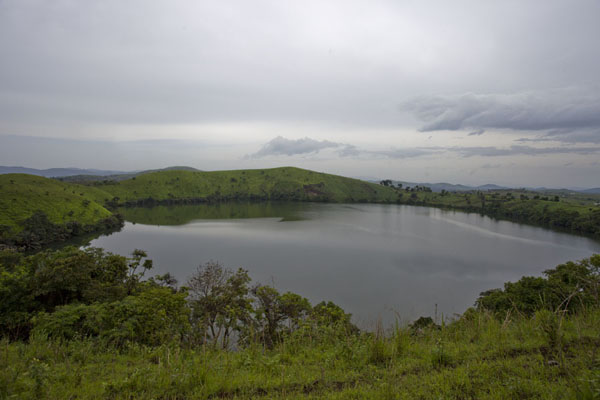
Fula herders graze their cattle in the open fields and bring them down to the lake to drink. The cool, green waters are immensely deep but swimming is possible from the muddy banks. To camp, contact the Senior Divisional Officer in Wum for permission. The locals can be paranoid about their lakes – the crater lakes are supposed to be the homes of the spirits of the fons, and many locals still believe that Western scientific experimenting caused the event in Lake Nyos. Foreigners are regarded suspiciously by some locals. Because of all the time we had spent driving, we didn’t go to the lake.
WEH. The last chance on the road for pumped water, market produce and restaurant food (can eat at the market). The road branches here – to the right (south) is the Small Ring Road and the town of Fundong.
Continuing on the main Ring Road, the road became wilder. We stopped at a viewpoint high above the valley below. We soon had most of the males from the village there to inspect us. Everyone was related and they all had the same appearance. Muslim with good English, they herded cattle and grew maize. They told us about the motorcyclists that had raced by in the early afternoon, visited Lake Nyos and returned several hours previously. I had shown Mark our planned route and they have obviously adopted it. It sounds like they have made it a race. Possibly they are staying in a hotel in Weh?
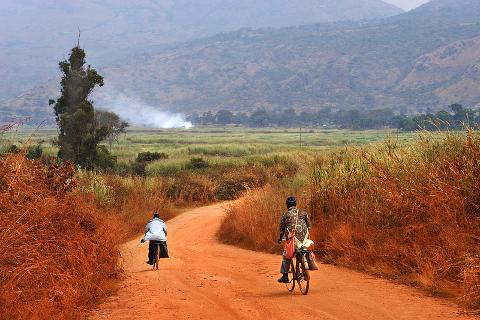
The road switchbacked into a broad valley where a collapsed bridge would stop all further traffic. Beyond the bridge, the population diminished dramatically and the landscape became prettier and vibrant with colour especially after the rains have started. The road also deteriorated and we were back to the snail pace. There were lots of sharp rocks. It required another two hours to get to Lake Nyos over several ridges. We passed several small villages strung along the road. At 6pm, we met several people carrying wood and water along the road.
The air has been full of smoke and views of the surrounding mountains poor.
LAKE NYOS (30kms from Weh). The dead village of Nyos is on the Ring Road itself (not south of it as marked on some maps). There is a small village there with a 3km paved road south to the lake. This deep crater lake was the site of a mysterious natural gas eruption in 1986 when a suffocating carbon dioxide cloud billowed off its surface and rolled northwards down the valley towards Su-bum killing up to 3000 people. Scientists believe that a tremor or a reaction between the warmer surface waters and the cold carbon dioxide-saturated waters of the lake depths caused the huge release of gas, something that could happen again at any of the deep lakes in the region. The caretaker believed that a rock fall from the side of the lake caused the eruption of gas. As a preventative measure, scientists have been venting a number of lakes to decrease gas pressures at the bottom. The lake is now vented from below, which can be seen from the lake shore.
Se-bum (30km from Weh). A scattering of houses and smoke-stained compounds looped along the valley is the only settlement of any size in the Nyos area. It suffered many casualties from the gas disaster. It has spectacular avocadoes. Camping or staying with locals are the only options here.
As the road from here to Nkambé was supposedly the worst part of the Ring Road, we planned on turning back at Lake Nyos, return to Weh and follow the Small Ring Road back to Bamenda.
We arrived at Lake Nyos just as dark was descending. A caretaker wanted us to stay in a compound well above the lake to the north. The army has not been here for a few years as the 11 soldiers had been redeployed to the Nigerian border to fight Boko Harum. There is a large collection of white-washed buildings in the compound, all built for the scientific studies and now used little. The caretaker was the only person here. After setting up our tents, we had an interesting dinner of sardine sandwiches, baked beans, chocolate and wine. Andrew had bought a large 6-litre jug of surprisingly good Cameroonian wine. Erasmus had never eaten food like this before, but seemed happy and settled into the back of the 4-Runner.
The caretaker was a wealth of information about road conditions. Apparently there is a well-graded road further along the Ring Road directly to Fundong and the Small Ring Road and the 4-WD part of the northern section of the Ring Road was supposed to be in good shape as it had been graded recently.
When the lake was first vented, a geyser 150 feet tall was produced. Now there are three small geysers about 2m high in the middle of the lake and 3 platforms or buoys. The lake is nearly circular and has some impressive cliffs on the south shore. It would be a challenge to walk around.

We had a flat tire in the morning, but there was a spare.
For completeness sake, I will continue the description of the Main Ring Road. As already stated, this road is now apparently easily driven.
KIMBI RIVER GAME RESERVE (50km from Weh going clockwise and 2-3 hours drive from Nkambé coming counterclockwise). Only accessible by 4×4 in the rainy season, it is nearly non-existent, save a few road signs and an unoccupied “headquarters” at the eastern border. It’s definitely wild, but with few signs of life. There are supposedly waterbuck and buffalo, but they have suffered severely from poaching. There are no vehicles for hire.
MISANJE (74kms form Weh and 22kms from Nkambé). A pleasant market village with a small auberge. A branch road here heads north 17km to Dumbo and the start of an exceptional 40km trekking route (foot traffic only) into Nigeria. Customs and immigration is at Dumbo. The trek is a gentle climb that levels out for a few kilometres before reaching the edge of the escarpment and the steep, beautiful descent into Nigeria. The first small town your reach is Bissaula where there is customs and immigration.
On our second day, we drove 9kms along the Ring Road on a rocky track and then turned south on the road (north went to Su-bum) described by the caretaker as “good” and only 35kms to Fundong.
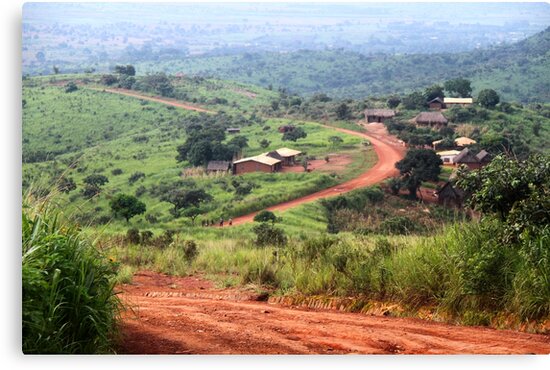
A very good road at the beginning and end, it deteriorated to a full-on 4×4 track as we went over a pass in the middle. Any normal vehicle would not have been able to get over this section. We passed many houses during the good part of the road and all fields had been burned and ready for planting. The kids were very excited to see white people and a real vehicle. They scrambled off the road up the ditch on our approach. Most of the people wore very unclean clothes and the kid’s clothes were in tatters. The mountains were nice with rocky bluffs. We stopped at a nice viewpoint across the rolling hills dotted with houses.
Two kilometres before Fundong, we turned east to see the Fon of Kom, the head fon over about 8 other local subfons. They looked like they had few visitors and didn’t offer us a tour. The driver noticed the left rear tire was losing air and we left rapidly to get back to the road junction. We drove for a while on the flat tire. Both flats were loaded on a motorcycle and taken into Fundong for repair. We bought bread, tomatoes, avocados and an onion and had a delicious lunch at the junction. A small bar had warm beer.
B. SMALL RING ROAD
There’s infrequent public transport along this route but is completely paved all the way to Bamenda.
FUNDONG. Hotels: Millennium Summer Hotel.
Daily transport back to Bamenda along a flawless paved road.
Fons Palace (Fon of Kom). This was supposedly a great visit to a very old-fashioned palace, like a medieval courtyard, a 20 minute drive up the hill behind the town center. The fon is old and speaks through an interpreter. Bring some booze as a present and make sure you can drink out of your hand. Remember the claps and low bowing.
Chimney Waterfalls.
BELO (2 hours from Bamenda). Good ecotourism setup with a range of treks in the area. Horseback rides (10,000 CFA for full day or stay in local homes at 8000 CFA per night including meals).
Ijim Forest. A beautiful 3-hour hike. Borders the Kilum Forest and Mount Oku.
We didn’t do any of these things as we had spent so much time with the flat tires.
We returned to Bamenda, bought gas, food for sandwiches and loaded a brand new tire into the back. We then all had a good dinner at a restaurant in east Bamenda and were on our way. We camped about 20 minutes outside of town in a school under the porch. The teachers around Bamenda have been on strike since November and the school was not being used. With open windows and doors, it was full of dust and dirt. A caretaker was on the grounds and didn’t mind us camping there.
Erasmus said that because the Northwest state around Bamenda was English speaking, it was constantly ignored by the national government. It is also why the Bamenda area has always been the site of political unrest.
The towns we drove through seem identical to virtually every other town we have passed through since Senegal. The businesses, schools and people all look the same. The landscape, except for a few islands of forest (SW Sierra Leone, Eastern Nigeria around the Drill Ranch and Western Cameroon to Bamenda), has also been similar.
C. EASTERN RING ROAD
After returning to Baminda, we headed north to do the eastern section of the Ring Road. The road was pot-holed filled asphalt. We expected to see some gorgeous tea plantations and very nice mountain scenery along the whole route.
Bambur (12km from Baminda).
Ndop (43kms). Road goes through the Sabga Hills.
Bamessing. Handicraft center and pottery workshop.
The road to Kumbo was potholed pavement alternating with rough dirt/gravel. The red dust covers absolutely everything within 50m if the road – these must be some of the dirtiest towns on earth. One of the tires fixed yesterday had a slow leak, so we stopped before Ndop, put the new tire on and fixed the damaged tire which then became the spare. It was interesting watching the tire guy do all the work with manual tools.
TAKIJA. 10kms north of Kumbo on a dusty dirt road, this small village has the region’s largest cattle market every Friday. As luck would have it, it was Friday and we arrived at 11am. I ended up talking to an official from the town keeping track of the sales who was very informative,
Farmers wanting to sell cattle bring their small herds of 10-30 animals by walking them from as far as 50kms away in the morning. – each seller gave his identity card and listed the number of cattle he was bringing for sale. The tax was 500CFA for each animal sold and 500CFA for each animal bought. Most of the cattle arrived by 1pm and were moved into a huge corral. The cattle were purchased, money changed hands without us ever seeing money (they all had a handful of coins) and all deals brokered by the evening.
Almost all of the cattle were noncastrated males each with a paint “brand” signifying the owner. There is no selective breeding as all the males are fertile and thus calves are born throughout the year. Some of the animals looked well fed but most were thin, and of the local breed – smaller long-horned animals with a hump. All were pastured and no hay was stored for lean times. Grown animals purchased were for slaughter in the area and small, immature animals would be taken back and fed through the rainy season. Because of the lack of refrigeration animals were slaughtered as needed. There were possibly 200 head up for sale on the day we were there and not all would be bought (the unsold animals would be trailed by foot possibly to Bamenda or even to Douala where prices would be better). It all looked confusing there were no small corrals or ways to keep animals apart. At certain times of the year (November and December before the annual pre-Christmas festivals), the entire corralled areas could be full with as many as 2000 cattle. Most of the buyers were Muslim.
Prices varied from 230,000 to 400,000 CFA depending on the animal and time of the year.
KUMBO (2-3 hours from Bamenda)
Stands on a plateau 2000m above sea level, it is one of the largest towns in the Grassfields. Has accommodation, banks and two hospitals. Market every 8 days and once a year a spectacular horse race in November.
Hotels: Central Inn (bottom). Merry Land (better). Fomo 92
Nightclubs: Samba.
Banso Chiefdom. Part of the Nso linguistic group, it is one of the most powerful, equal to those of Bali and Bafut. They were defeated by the Germans in 1906 and their fon executed in Baminda, bitter history that they have never reconciled. A predominately Catholic community, the Banso have traditions: not offering traditional office-holders your hand when greeting, nor cross your legs while seated, nor drink in their presence, nor pass the traditional policeman on his left.
Palace. Has old and new sections, the latter Islamic. Home of the fon.
We visited this palace that started with a pictorial history of the fondom. The people arrived from northern Cameroon in 1384, actually 2 brothers and a sister. The brothers became fons at Oku and Mbiene and the sister became fon of a people about 25kms north. During a war, all the males were enslaved except one who became the fon in a line of 19 fons to this day.

The present fon had ~150 wives, but many have died (several were inherited from the previous fon), and new ones added so that there may be 50 or so now. The fon was not present and we toured a courtyard and the outer square with several totem building supports and door surrounds. We were asked for a donation – 500 CFA was not enough and we gave 1000. This was not the sophisticated tour given in Bafut.
Cave. Half a km east, the resting place of old skulls from long-ago traditional feuds.
We went for lunch in Kumbo at a restaurant that was the best in town but not much – no menus and a limited selection of local food.
ELAK. A detour off the Ring Road from Kumbo, it is the principle village of the Oku fondom, renowned for witchcraft, traditional medicines and a rich culture.
Elak is situated high on the northern slopes of Mount Oku (3011m), the second highest point in West Africa. The climb passes through steep farmland, then into the Kilum Forest – with the Ijim Forest constitutes the largest remaining fragment of the montane forest that once covered much of the highlands. Diverse birdlife. Then subalpine grassland. Must present the fon with a bottle of whiskey to get permission to climb.
The road up here was very rough fine dirt. We passed through large fields on the rolling plateau and several villages on the way. Elak is large and had pavement so buildings were spared the fine covering of red dust.
On entering the small courtyard in front of the palace, we were greeted by the fon himself. A slightly overweight guy who appeared to be in his early 60s, he had a strong presence.
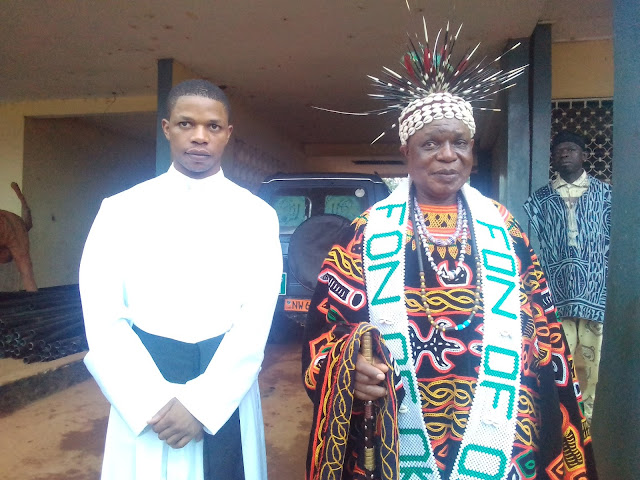
We chatted for about an hour and he showed us the magnificent carved thrones in a small enclosure off the courtyard where he viewed his subjects. They were covered in small, carved figures. He coughed a few times and the harsh, wet rattle sounded ominous (my guess was bronchiectasis). Even though he appeared outwardly healthy, I had concerns about his longevity. We took pictures of us with the fon in front of the throne area. We waited for the palace guide who was attending a burial to come to show us around. The buildings on the side of the courtyard all had magnificent carved totems, usually three figures, two human and one animal. The fon was concerned that the guide not see him on the day of the burial as it would be bad luck.
We met the guide in a small office and given the price list. A general site visit of the mountain, lake and waterfall was 10,000 CFA per person. If we wanted to camp, we would have to pay 2 guards 5,000 each. Apparently there had been some robberies at the lake and they were there for our protection. The fee for seeing the palace museum was 2000 and a donation of 2500 per person was also expected. We baulked at the steep prices and finally negotiated 5000CFA to cover the donation and a short visit to the lake in the morning. But our plans of camping were out.
The palace could not be visited and we were taken around the side to look down on the row of mud brick homes where the queens lived with their children. Two of the queens were on the path. One gave very seductive looks and appeared to have not gotten it in a while. I would doubt that a man of his age and health was very sexually active.
The palace museum is not to be missed. It was full of the most fantastic array of carvings – elaborate stools, thrones decorated in cowrie shells, tables, masks and animals. Three small rooms had all the costumes of the secret societies, one royal and the other for lesser subjects – all had mesh veils making their faces invisible and amazing masks and head dresses. One appeared to be a suit of long woollen underwear decorated with red feathers. Another had an enormous one meter tall carving on top of his head. Many were covered in carved wooden decorations. The caretaker who showed us around erroneously said we could take photos, something I was sure was not allowed and Bruce and Andrew snapped shots furiously. The main guide appeared and said that no photos were allowed. After touring several small rooms, we were taken to the outside to see four small gift shops full of all fantastic carvings. Prices were unbelievably cheap – stools were 35-65,000 and a magnificent coffee table only 100,000. I dreamed to bringing a shipping crate up here as everything would bring 5-10x that price back home. We didn’t buy anything because of their size and weight. Postage home would be three times their purchase price. The Oku are easily the best carvers in the world.
The four who had been motorcycling the Ring Road appeared, all covered in a thick layer of dust. They had continued around the north end of the Ring Road. Apparently one view was the best of their trip with views down from a pass onto a wide plain. At the multiple police checks, they had to show passports and give bribes averaging 1000 CFA per motorcycle. Their plans were to climb Mount Oku without paying any of the fees (a guide was also required). They had nothing but glowing reports of how wonderful their experience had been – it sounded much more amazing than ours.
They had also run into the three cheapos taking public transport. They had also ended up hiring motorcycles and drivers. It must have been difficult with their heavy packs.
With no ability to camp at the lake, we stayed at the King David Hotel, owned by the fon and managed by the head guide. The simple rooms were 5000 per bed. In the small bar were two amazing older Cameroonians, one an educator and one a farmer growing organic coffee and fish. Both were eloquent, intelligent and great conversationists. They had been at the burial and explained many of the customs – casket carriers are paid and give a performance at the funeral and they argued the appropriateness of one of the casket bearers wives entering the performance. Customs are deeply ingrained. I chatted with them both for several hours over several beer.
The next morning, I expressed my concern about the fon’s health to the guide/hotel manager. He phoned him and Erasmus drove us done to the palace to check him out. He was in the courtyard again, dressed casually in an American logoed sweatshirt. He had a couple of his wives fetch all his medical equipment from the palace while I waited in the fon’s office. They brought two automatic blood pressure cuffs, one of which worked, an abdominal waist belt/vibrator and a neck massager, but no stethoscope. I suggested we go to the hospital, the fon wanted to take a bath, I suggested it was not necessary and he changed his clothes. While waiting, one of his wives stood in the doorway of the office. She was poorly dressed in sweat pants and an old top. She said there were too many wives, about 50, and 300 children. I asked if she was happy and she quickly replied “no”.
The emergency at he hospital was a small dark room with no lights, an old couch and a small bed in a small room. I took his blood pressure (very high and he responded that he had run out of his meds two days previously). His chest was surprisingly clear (although the stethoscope was of very bad quality) and I found some antibiotics for him in the pharmacy (but not the ones I suggested). The doctor arrived and we discussed the problems. He was going into Kumbo to see the doctor in 2 days.
Lake Oku – on the western slope at 2200m, is a spectacular deep green encircled by a splendid dark forest. Sacred so fishing and swimming are forbidden.
We stopped at a parking area in front of a huge under-construction Baptist church, checked with a guard who ensured we had paid for access to the lake and walked down a long flight of stone steps to the water’s edge. Camping would have been difficult as the only flat area was a small stone terrace in the small area of cleared trees beside the lake. A path extended in one direction but it unlikely went far along through the heavy forest. We took another paved road down to the main highway from the lake.
We stopped at a magnificent viewpoint over heavily furrowed fields and a large village far below. Hiking to climb the surrounding low mountains could have consumed several days.
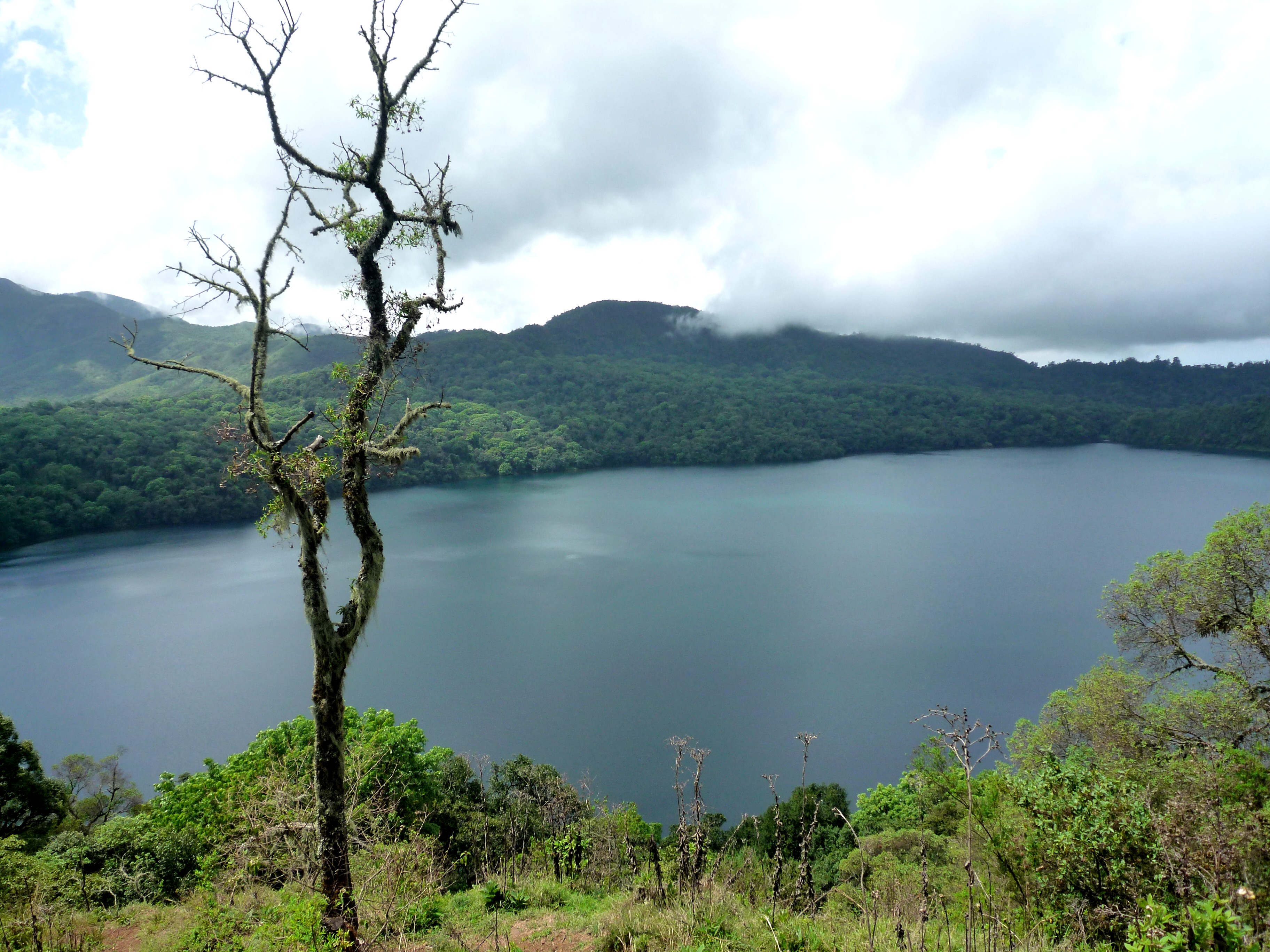 The road descended steeply to the Bamendq/Kumbo highway passed some spectacular scenery including a long rock wall.
The road descended steeply to the Bamendq/Kumbo highway passed some spectacular scenery including a long rock wall.
After Ndop, a dirt road headed over to Foumban and we took it instead of the proposed mountainous route between Jakiri and Foumban. The road was rough dirt for 75kms. One hill was so sandy and rutted that a 4×4 would have been required to get up it. We stopped in one town for lunch, bought some stale French bread and had boiled egg and tomato sandwiches and pineapple. We ate on a spare table in the market. This town was completely French speaking.
FOUMBAN
75kms to the SE of Jakari, it is the capital of the Bamoun people and seat of their sultan, this town has history and culture giving it the most touristy feel of any town on the road. It is French speaking. The road between Jakari and here is definitely one of the most beautiful in the area, passing through the spectacular Mbam massif, palm tree plantations and striking villages with an Islamic influence. We didn’t take this road but one to the south.
Here north and west Africa meet along with Islam and Christianity. National art capital. The religion, Shumon, is a combination of Christianity, Islam and animist.
The Bamoun Empire dates from the 14th century with a lineage of 17 kings in the present dynasty.
Around town are unusual effigies of bizarre figures full of nails and caricatured Africans.
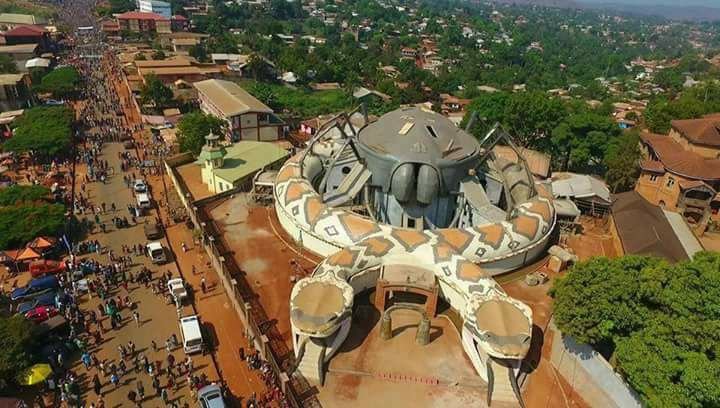
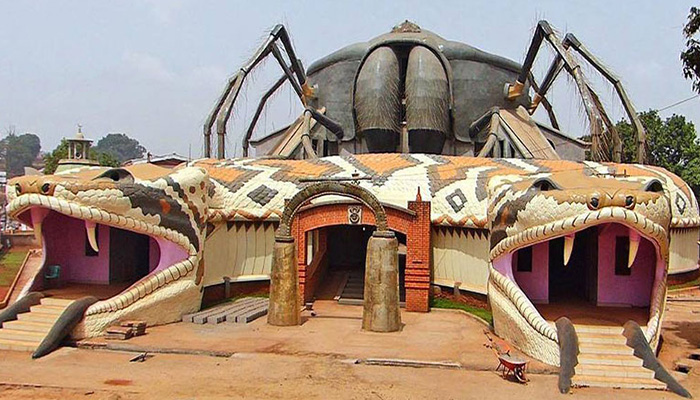
The museum
Royal Palace. Built in 1917 by Sultan Njoya (the present sultan lives in a new one), it is an architectural achievement, unique in Africa. It combines assorted elements of German baroque with pure Romanesque forms (like the German castle at Buéa). Approached by a vast courtyard lined with rónier palms, it is made entirely of locally made bricks supported by strong pillars. The walls are carried by arcades and embellished with balconies worked with intricately carved wood.
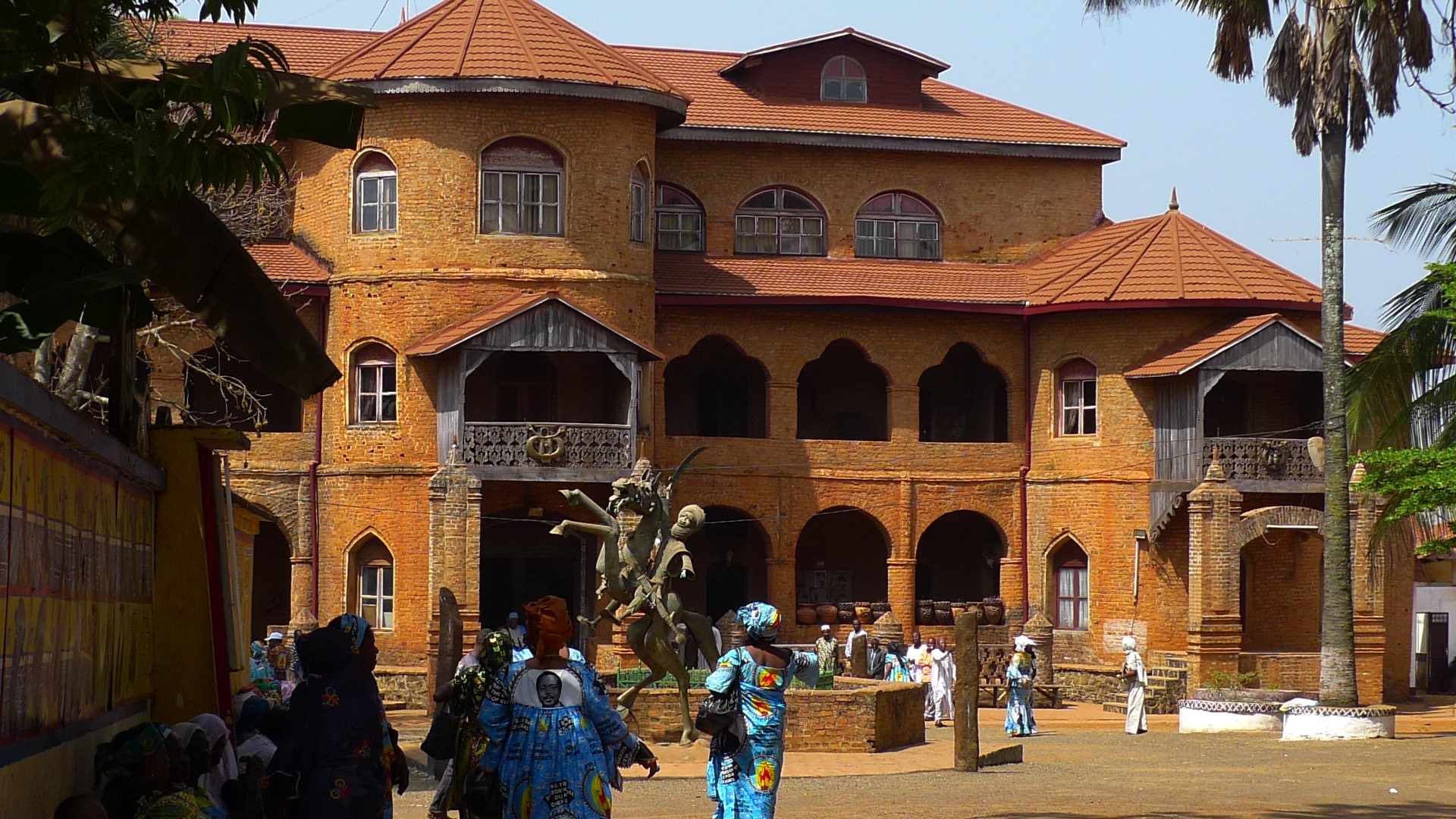
There is an impressive entrance hall, armoury and reception hall with its ceiling supported by 4 majestic columns. In the morning, the sultan holds court in the palace foyer. On Fridays at 1:30pm, court musicians play for the sultan while brilliantly dressed subjects pay their respects and seek his advice.
The Sultans Museum inside the palace is one of the most interesting in Cameroon with bilingual guides. A private collection of memorabilia from the long line of kings has thrones decorated with beadwork and sculptures.
Village des Artisans. This is a major distribution centre for crafts and antiques from all over Cameroon and neighbouring countries, 2km from the centre. Craftsmen from all over the country cast and beat metal and carve wood.
Musée des Arts et des Traditions Bamoun. Wooden plaques portray Bamoun history.
The first two choices of hotels in Foumban were both closed so we had to settle for the Hotel Pekassa de Karche – two rooms with only double beds for 25,000 CFA each so I slept with Andrew and Bruce slept with Erasmus. Initially there was no water and the rooms came with only one towel and they had run out of towels. This is Africa. This was a Saturday and the town was busy with multiple weddings and heavy traffic. In the busy main street, Erasmus rear-ended the car in front of us. Minimal damage was done but took another hour to clear up.
BETWEEN KUMBO AND LAKE NYOS
JAKIRI. Has a spectacular range of hills rearing up near the town. Hotel Trans Afrique has panoramic views of the Ndop Plains and Lake Bamendjing.
North is the most heavily populated part of the Ring Road.
NDU. Cameroon’s largest tea plantation, begun by the British in the 1950s. Has a filling station. Dallas Hotel.
MBOT. A Chiefdom with its own fon and palace.
Road to Nkambé continues at an elevation of between 1500m and 2000m, with population decreasing gradually until Nkambé.
NKAMBÉ. On the NE side of the Ring Road, this large town signals a return from remote regions with restaurants, bars and a few hotels (Millenium Star). Daily buses link to Bamenda via Kumbo.
Other Ring Road experiences.
Tammy, Andy and Blake took a share taxi and private taxi as far as Wum. Share taxis usually seat four in the back seat, but they purchased the fourth seat so there was only three across. They hired mototaxis to take them up to Lake Wum (which was just ok) and they camped in a school yard that night in Wum. They then used mototaxis to get to Lake Nyos and onto Nkambe in one long day. From there they used a combination of share and private taxis to get to Kombo where they stayed the night. They took a share taxi to Babungo (it took till 11am to fill a share taxi. It was then 13km to Mbi Crater by mototaxis. This is a huge crater with great views from the high viewpoint but it was smoke obscured. It was then back to Babungo and then 9.7km to Ndop and back to Baminda by share taxi on the same day. Total cost per person was 57,000 CFA each.
The motorcycle group stayed in a hotel in Weh, Nkambe and Oku. They visited the Oku Fon’s museum. When we saw them in Oku, they looked like they had heavy makeup on with raccoon eyes and dust covered faces. Mark climbed Mt. Oku on their fourth day (account to follow) and attended a wonderful cultural event that evening while the others returned to Bamenda. They ate a huge amount of dust on the mototaxis. They were also stopped at every police check and usually had to pay bribes. It was hard on their backs and bums with so many hours on a motorcycle.
Toby took public transportation to Wum and then hired a mototaxi to Lake Nyos. He then took mototaxis and walked to Fundong, rode a horse and visited a very good tea plantation above Belo. He returned on his fourth day.
TRIPS FROM BAMENDA
1. Bali. Of the regions main chiefdoms – Bafut, Bali and Nso – only Bali Is not accessible by the Ring Road. A Chamba settlement, they are part of the Adamawa linguistic grouping, and were founded relatively late, around 1830. Its history is a serious of wars ad conflicts, notably with the nearby fondous of Bafut, and as recently as 2007, with the neighboring Bawock. Only 20km west of Bamenda, it is a satisfying day’s excursion with beautiful scenery along the way. The Fon’s Palace, not so much to see, has the hope of having an audience with the Fon (chief) himself, a German-educated philosopher who is always keen to meet visitors. His palm wine is the best in the area. Recommended are a sacred cave to see the skulls of Bali’s many warrior enemies and Torthung’s Tower of Babel, an incomplete 72-room prevented from happening by witchcraft and Forthung’s death.
2. Awing Crater and Mount Lefo. Off the Bafoussam road south of Bamenda, you can swim in the lake and climb Mount Lefo, at 2250m, the fourth highest mountain in Cameroon, a demanding day’s climb from Lake Awing. There are great views of the Bamenda plateau and crater lakes.